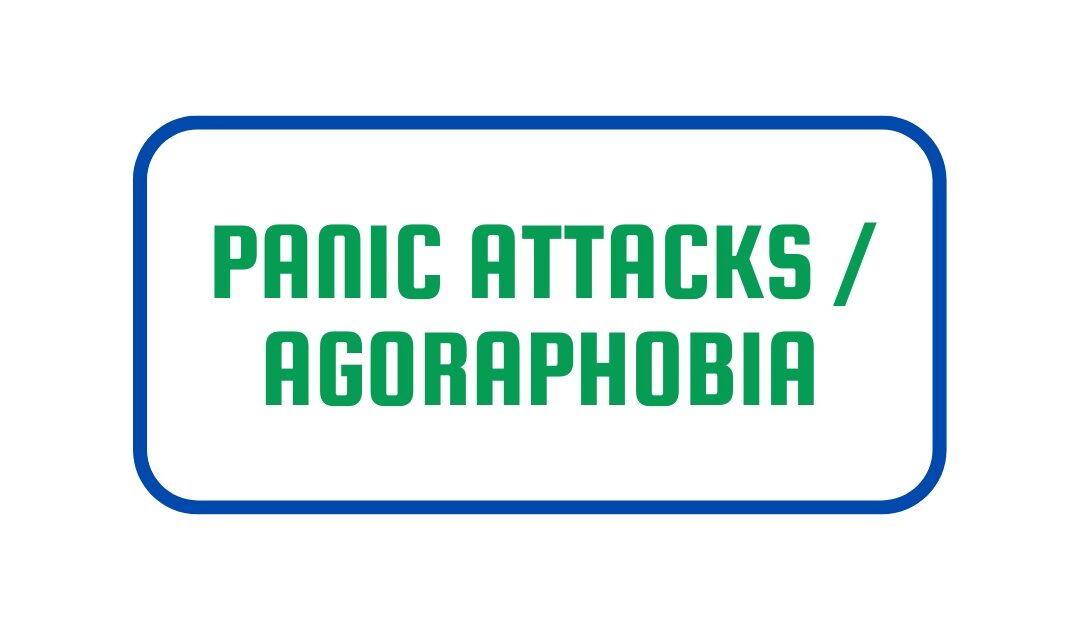What are the symptoms of Panic Attacks?
- Heart palpitation
- Trembling
- Sweating
- Shortness of breath
- Feeling of choking
- Dizziness
- Fear of losing control
- Fear of dying
Panic attacks can occur alone but are most often accompanied by what is called agoraphobia.
What is Agoraphobia?
Agoraphobia is anxiety about being in places in which escape might be difficult, embarrassing, or in which help may not be available in the event of having a panic attack (either unexpectedly or by a predisposed situation). Individuals with agoraphobia tend to seclude themselves within their homes. Some can venture further from their places of safety only if they have a friend or close relative with them. Thus, the individual will often isolate and avoid all potential situations in which they may fear a panic attack may occur.
Fears often associated with Agoraphobia often include but are not limited to:
- Being outside the home
- Being in open spaces
- Being in a uncomfortable/unsafe place or situation
- Being in an enclosed area
- Feeling trapped
- Being in a crowd
- Standing in line
- Being on a bridge
- Traveling in a bus, train, or automobile
What Causes Panic Attacks/Agoraphobia?
Genetics: Panic disorder often runs in families. If you have family members who had panic disorder, you are about two times more likely to develop the disorder yourself. Also, women are twice as likely to develop a panic disorder. This may suggest a genetic predisposition in women.
Psychology: Panic disorder sometimes begins after major life events, traumas, or life-threatening situations. Loss and separation are especially linked to the onset of panic disorder.
Physiology: Researchers suggest that a physiological dysfunction in the brain may cause panic disorder. An organ in the brain called the amygdala is responsible for initiating your fear response. People with panic disorder may have an abnormally low baseline in their amygdalas, which causes sudden and unexplainable fear reactions.
The good news?
Anxiety Disorders are one of the most common types of mental health problems and one of the most treatable.
What treatments are available?
Medication
Medication can reduce/eliminate the symptoms of anxiety and eliminate the possibility of having panic attacks by working with a chemical imbalance in the brain. Certain antidepressants are helpful with symptoms of anxiety and are often non-addictive. High potency benzodiazepine tranquilizers have also been found to be helpful when symptoms need to be reduced quickly, such as when flying in an airplane. People with anxiety may need to consult a doctor about getting on medication in addition to psychotherapy.
Cognitive Behavioral Therapy (CBT)
The cognitive model of panic disorder suggests that panic attacks are a result of catastrophic misinterpretations of either benign bodily sensations or anxiety related symptoms. Anxiety is a normal response to threat/worry. Increased heart rate/palpitations is a common bodily sensation associated with anxiety. However, a person vulnerable to panic may interpret the sensation as a sign of something much more serious and this interpretation will increase their anxiety thus leading to a panic attack.
CBT for panic attacks and agoraphobia rests on the beliefs that a person has a mistaken belief that they are in danger and the anxiety is a natural reaction to the body being convinced it’s in danger. This creates a vicious cycle between bodily sensations, distorted thoughts, and anxiety, which will quickly lead to a panic attack. In order to reduce the symptoms of one’s panic disorder, a person needs to understand that the belief that they are in danger is untrue and to explore the deeper roots of this belief.
CBT for panic attacks has two components: identifying and changing the distorted thinking patterns that maintain anxiety (cognitive) and desensitizing anxiety through exposure to feared situations (behavioral). The main focus of treatment for both components depends on the individual’s specific problem. For example, exposure therapy alone effectively treats specific phobias, such as a fear of heights. Whereas, cognitive therapy alone successfully treats panic disorder without agoraphobia. If you have a significant amount of agoraphobic avoidance along with your panic attacks, then you will need to work both on changing your thinking and exposing yourself to the situations you fear.
CBT for panic disorders aims to challenge and reduce the person’s belief in the danger of their symptoms, therefore breaking the cycle of panic. After this is accomplished, CBT aims to reduce avoidance and safety behaviors to further challenge the person’s fears through exposure, systematic desensitization, and shaping (just to name a few).
Acceptance and Commitment Therapy (ACT)
ACT (a form of Cognitive Behavioral Therapy) uses strategies to help you change your behavior, such as those related to general anxiety, panic attacks, and agoraphobia. ACT uses methods that help you learn through experience such as mindfulness and acceptance to address the fearful thoughts and problematic behaviors associated with panic disorder. In addition, ACT seeks to help you loosen the grip that we allow thoughts to have over our behavior. Homework can play an integral role in the application of these techniques, by supporting the in-session therapy. Homework is especially useful. It allows the client to utilize these principles in situations that cannot be created in the therapy sessions, such as public situation for someone who struggles with a panic disorder.
Other Psychotherapies
Psychodynamic therapy and virtual reality (which is a fairly new treatment) are other treatments that are helpful with panic disorders. But the most promising and empirically validated treatment is CBT.
Can Patients with a Panic Disorder and/or Agoraphobia have other illnesses?
The severity of complications and depression in patients with comorbid panic disorder tend to be greater than with either depression or panic alone. The problem of comorbid panic disorders and other anxiety disorders such as simple/specific phobias and social phobias are often seen in this population. Finally, panic disorder as well as substance abuse/dependence, accompanied by depression, is seen quite often. This is by no means an extensive list of the other illnesses that could accompany an individual with a panic disorder. Illnesses such as Post Traumatic Stress Disorder and Obsessive Compulsive Disorder are frequently seen in this population. These comorbid conditions make a panic disorder more difficult to recognize and diagnose, thus making it more difficult to treat successfully, than an uncomplicated panic disorder.
Where can I get more Information?
Websites/Hotlines:
- About.com (www.panicdisorder.about.com)
- Overcoming Panic Attacks (www.paniccure.com)
- No More Panic-Agoraphobia (www.nomorepanic.co.uk)
- National Institute for Panic Disorder Education Program (1-800-64-Panic)
- Anxiety Disorders Association of America (1-301-231-9350)
Books for Patients and Families:
- Bourne, Edmond (2000) The Anxiety and Phobia Workbook. New Harbinger Publications Inc. Oakland, Ca.
- Capps, L., Ochs, Elinor, & Bruner, J (1995). Constructing panic: The discourse of agoraphobia. Harvard College, Ocho Elnor, IL.
- Peurifoy, Reneau (1988). Anxiety, phobias and panic: A step by step program for regaining control of your life. Time Warner Book, NY.
- Sheehan, David (1983). The anxiety disease: New hope for millions who suffer from anxiety. Scribner Book Co. New York.
- Wilson, Reid (1996). Don’t panic revised edition: Taking control of anxiety attacks. HarperCollins Publishers, NY.
Books for Clinicians:
- Barlow, David (2002) Anxiety and its disorders: The nature and treatment of anxiety and panic. Guilford Press, NY
- Beck, A.T, Emery, G., Greenberg, A.L. (1985). Anxiety disorders and phobias: A cognitive perspective. Guilford Press, NY.
- Rygh, J.L, & Sanderson, W.C. (2001). Treating generalized anxiety disorder: Evidence based strategies, tools, and techniques. Guilford Press, NY.
Referrals to Cognitive Therapy in Your Area:
Academy of Cognitive and Behavioral Therapies (www.academyofct.org)

